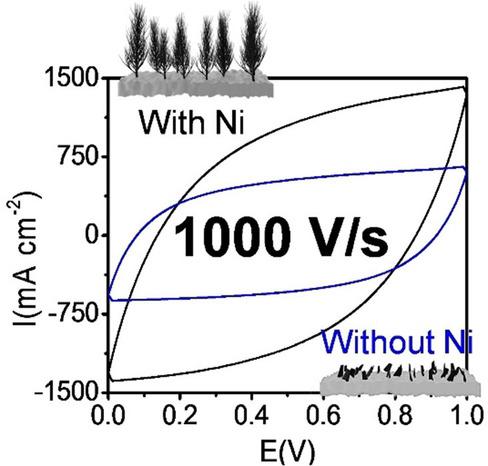当前位置:
X-MOL 学术
›
Batteries Supercaps
›
论文详情
Our official English website, www.x-mol.net, welcomes your feedback! (Note: you will need to create a separate account there.)
Nickel Alloying Significantly Enhances the Power Density of Ruthenium‐Based Supercapacitors
Batteries & Supercaps ( IF 5.7 ) Pub Date : 2020-06-19 , DOI: 10.1002/batt.202000110 Ahiud Morag 1, 2 , Nitzan Shauloff 1, 2 , Nitzan Maman 2 , Natalya Froumin 2 , Vladimir Ezersky 2 , Raz Jelinek 1, 2
Batteries & Supercaps ( IF 5.7 ) Pub Date : 2020-06-19 , DOI: 10.1002/batt.202000110 Ahiud Morag 1, 2 , Nitzan Shauloff 1, 2 , Nitzan Maman 2 , Natalya Froumin 2 , Vladimir Ezersky 2 , Raz Jelinek 1, 2
Affiliation

|
Supercapacitors operating at high frequencies while exhibiting high capacitance have been challenging to fabricate due to high resistance and constrained ion diffusion in the active layers. To overcome these limitations, thin layers of pseudocapacitive materials with high theoretical capacitance can be used. Still, construction of such electrodes exhibiting effective ion diffusion, sufficient electrochemically‐active surface area, and high conductivity has encountered significant difficulties. Here, we integrated nickel atoms into a ruthenium layer through a simple electrochemical deposition method, producing a thin electrode comprising hexagonal nickel ruthenium (NiRu) nanodendrites. Further oxidation of the NiRu alloy generated a thin surface layer of pseudocapacitive RuO2 exhibiting significant areal capacitance. A symmetric device from two NiRu/RuO2 electrodes displayed an energy density of 0.714 μWh cm−2 with a remarkable power density of 1500 mW cm−2, ∼250 W cm−3 for a full device. The NiRu/RuO2 supercapacitor outperforms commercial capacitors in both energy and power densities and may replace bulky capacitors in microelectronic devices.
中文翻译:

镍合金化显着提高了钌基超级电容器的功率密度
由于有源层中的高电阻和受约束的离子扩散,因此要制造在高频下表现出高电容的超级电容器具有挑战性。为了克服这些限制,可以使用具有高理论电容的伪电容材料薄层。尽管如此,这种具有有效离子扩散,足够的电化学活性表面积和高电导率的电极的构造仍然遇到了很大的困难。在这里,我们通过一种简单的电化学沉积方法将镍原子整合到钌层中,制得了一个包含六方镍钌(NiRu)纳米枝晶的薄电极。NiRu合金的进一步氧化产生了伪电容性RuO 2的薄表面层表现出很大的面电容。从两个尼汝/的RuO对称装置2电极显示0.714μWh厘米的能量密度-2具有1500毫瓦厘米的显着功率密度-2,〜250W¯¯厘米-3一个完整的设备。NiRu / RuO 2超级电容器在能量和功率密度上都优于商用电容器,并且可以代替微电子设备中的笨重电容器。
更新日期:2020-06-19
中文翻译:

镍合金化显着提高了钌基超级电容器的功率密度
由于有源层中的高电阻和受约束的离子扩散,因此要制造在高频下表现出高电容的超级电容器具有挑战性。为了克服这些限制,可以使用具有高理论电容的伪电容材料薄层。尽管如此,这种具有有效离子扩散,足够的电化学活性表面积和高电导率的电极的构造仍然遇到了很大的困难。在这里,我们通过一种简单的电化学沉积方法将镍原子整合到钌层中,制得了一个包含六方镍钌(NiRu)纳米枝晶的薄电极。NiRu合金的进一步氧化产生了伪电容性RuO 2的薄表面层表现出很大的面电容。从两个尼汝/的RuO对称装置2电极显示0.714μWh厘米的能量密度-2具有1500毫瓦厘米的显着功率密度-2,〜250W¯¯厘米-3一个完整的设备。NiRu / RuO 2超级电容器在能量和功率密度上都优于商用电容器,并且可以代替微电子设备中的笨重电容器。


























 京公网安备 11010802027423号
京公网安备 11010802027423号